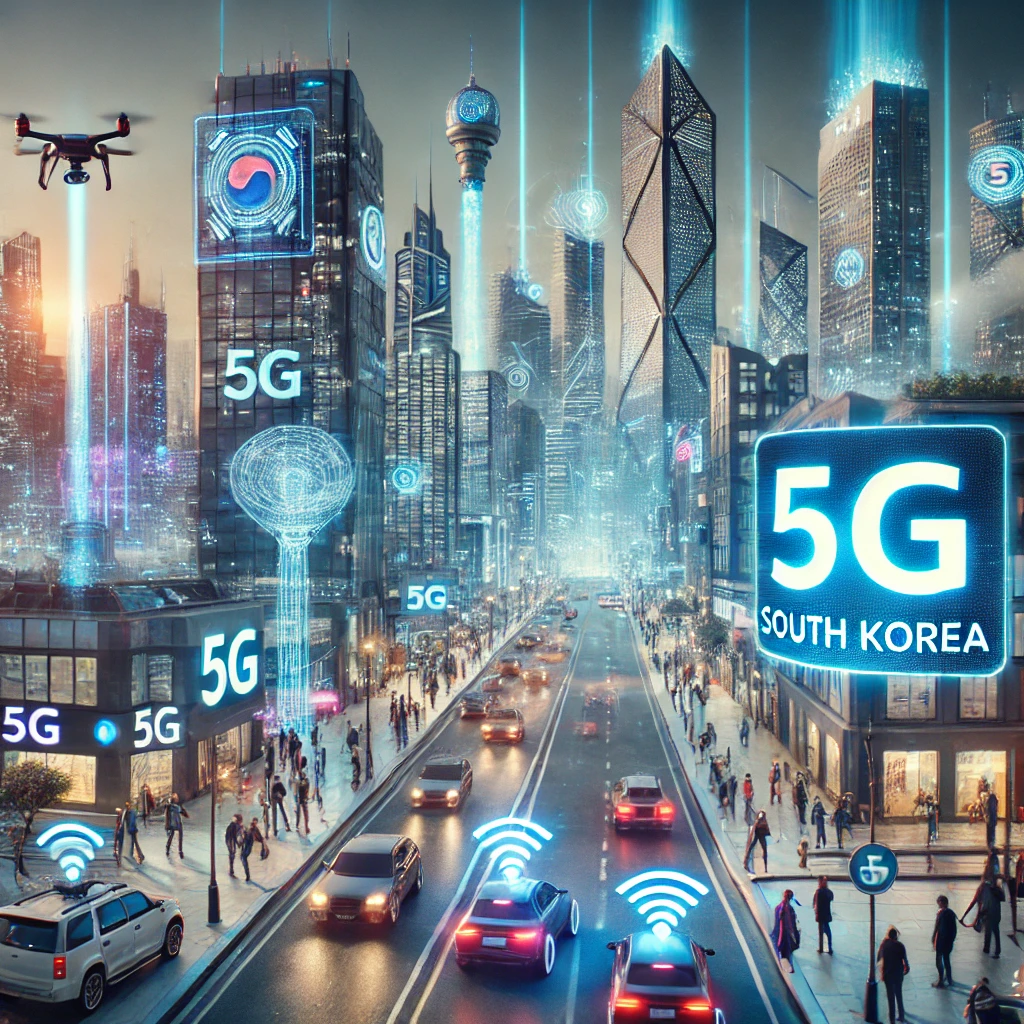Table of Contents
Introduction to 5G Technology
Fifth-generation (5G) technology represents a significant leap forward compared to its predecessors, namely 4G LTE and earlier mobile networks. At its core, 5G is designed to deliver unprecedented data speeds, ultra-reliable low-latency connections, and massive device connectivity. This technological advancement has the potential to revolutionize various sectors, impacting not only telecommunications but also industries such as automotive, healthcare, and entertainment.
One of the most notable features of 5G technology is its ability to achieve data transmission speeds that can reach up to 10 Gbps, which is up to 100 times faster than 4G. This increase in speed facilitates quicker downloads and uploads, enabling users to interact with digital content more seamlessly. Moreover, 5G is engineered to support higher bandwidth, allowing multiple devices to connect simultaneously without sacrificing performance. This is crucial as the number of internet-connected devices continues to rise with the advent of the Internet of Things (IoT).
In addition to enhanced speed and connectivity, 5G technology also focuses on reducing latency, achieving a target response time of one millisecond. This improvement is particularly vital for applications requiring instantaneous reactions, such as autonomous driving, remote surgeries, and augmented reality experiences. The efficient use of spectrum—combined with advanced technologies like Massive MIMO (Multiple Input Multiple Output) and network slicing—enables 5G networks to deliver these capabilities effectively.
The deployment of 5G technology promises to transform user experiences, offering a reliable platform for innovative applications and services. With its superior speed, lower latency, and enhanced device capacity, 5G stands poised to impact various aspects of daily life. As South Korea leads the way in this groundbreaking advancement, understanding the fundamentals of 5G becomes essential for grasping its future implications.

A Brief History of 5G Development in South Korea
South Korea has emerged as a frontrunner in the global rollout of fifth-generation (5G) telecommunications technology, marked by a series of significant milestones that highlight the nation’s commitment to innovation. The journey began in earnest in the early 2010s, as South Korean telecommunications companies and the government recognized the potential of 5G to revolutionize communication and spur economic growth. Research and development initiatives started gaining momentum, with various universities and private sectors collaborating to explore advanced technologies that would pave the way for the fifth generation.
By 2016, the South Korean government officially pledged substantial investments in developing 5G infrastructure, setting ambitious goals for both research funding and regulatory support. This commitment bore fruit as major South Korean telecommunications operators such as SK Telecom, KT Corporation, and LG Uplus accelerated their efforts. In 2018, South Korea became the first country in the world to launch a nationwide 5G commercial service, demonstrating the successful culmination of years of investment and innovation.
The roles of both the private sector and government in this endeavor cannot be overstated. The South Korean government worked to create a conducive environment for 5G development by offering regulatory support, streamlining processes, and providing financial backing for key projects. This synergy between public and private sectors established a dynamic ecosystem that prioritized cutting-edge technology. Moreover, South Korea’s hyper-connected culture and high consumer demand for the latest technological innovations fueled the rapid adoption of 5G.
In subsequent years, the deployment of 5G networks expanded further, enabling a wide array of applications from enhanced mobile broadband to critical Internet of Things (IoT) services. The unique collaboration between various stakeholders within South Korea’s tech scene showcases the important lessons other nations can glean as they embark on their own 5G initiatives. The timeline of 5G development in South Korea illustrates not just a technological evolution but also a cultural embrace of innovation that continues to shape the telecommunications landscape.
South Korea’s 5G Infrastructure: Building the Future
South Korea stands as a pioneer in the deployment and integration of 5G technology, primarily due to its robust infrastructure that has been methodically developed over the years. Central to this advancement is the strategic placement of 5G cell towers throughout urban and rural landscapes. The country has prioritized not only metropolitan areas but also remote regions to ensure comprehensive nationwide coverage. As a result, South Korea has established one of the most extensive 5G networks globally, positioned as a model for other nations aiming to replicate this success.
Furthermore, the collaboration between private companies and government entities has played a significant role in the development of this infrastructure. Public-private partnerships have enabled shared investments in 5G technology and resources, facilitating the rapid and sustainable expansion of connectivity services. This synergy has empowered telecom operators to reach widespread adoption without facing the typical financial constraints that often accompany such large-scale projects.
Additionally, investment in fiber-optic cables has been a crucial element in bolstering South Korea’s 5G network capabilities. Fiber-optics provide the high-speed data transmission necessary for 5G networks to function optimally. By ensuring a well-connected backbone, the nation can handle the increased data demands that come with advanced applications like augmented reality, the Internet of Things (IoT), and smart city innovations. This has not only improved user experience but has also positioned South Korea as a leader in technological advancements.
In conclusion, South Korea’s approach to building its 5G infrastructure through strategic cell tower placement, effective public-private partnerships, and significant fiber-optic investments serves as an exemplary model for aspiring 5G nations. The interplay of these elements creates a robust foundation for continued growth and innovation in connectivity, paving the way for the future of technology globally.
Impact of 5G on South Korean Industries
The advent of 5G technology in South Korea has ushered in transformative changes across various sectors, leveraging its high-speed connectivity and low latency to enhance efficiency and service delivery. One of the most significant sectors impacted is healthcare. With the implementation of 5G, healthcare providers are now able to utilize telemedicine more effectively. This includes real-time consultations and remote surgeries, which improve patient outcomes while reducing the need for physical visits, thus increasing access to healthcare services across the country.
In the realm of gaming, South Korea—home to some of the largest gaming companies—has seen 5G redefine the user experience. The ultra-fast speeds facilitate cloud gaming, delivering high-quality graphics and seamless interaction without the lag traditionally associated with online gaming. This capability not only enhances gaming experiences but also supports innovative developments in augmented and virtual reality, enabling more interactive and immersive environments.
Smart cities are another area experiencing profound changes due to 5G technology. South Korea is at the forefront of implementing smart city initiatives that aim to optimize urban infrastructure. With the integration of IoT devices, the 5G network supports advanced traffic management systems, energy-efficient buildings, and improved public safety measures. This interconnectedness fosters sustainable urban growth while also improving real-time data analytics across city services.
Moreover, the manufacturing sector has been transformed by 5G, adopting smart factory concepts that utilize automation and robotics. Industries are increasingly leveraging 5G to connect machinery and devices, enabling real-time monitoring and predictive maintenance. This results in reduced downtime and enhanced operational efficiency, which collectively boosts productivity levels across manufacturing plants.
In summary, 5G technology is significantly impacting South Korean industries, driving innovation and improving services in healthcare, gaming, smart cities, and manufacturing. The ongoing advancements and applications of this technology promise to shape the future of these sectors, underpinning South Korea’s position as a global leader in tech innovation.
Consumer Adoption and Usage Patterns in South Korea
South Korea stands as a pioneer in the global deployment of 5G technology, with consumer adoption reflecting the country’s advanced tech landscape. As of October 2023, statistics indicate that the majority of smartphone users in South Korea have transitioned to 5G-compatible devices. Approximately 80% of new smartphone sales are now comprised of 5G models, showcasing a market that is increasingly oriented towards embracing high-speed connectivity. This surge in adoption is a testament to the extensive marketing efforts by major telecommunications companies and the increasing availability of 5G infrastructure across urban and suburban regions.
In terms of service plans, South Korean consumers have diverse options tailored to meet varying needs for data consumption. The availability of competitive pricing and flexible contracts has incentivized users to switch to 5G services. Major telecom providers offer plans that not only provide unlimited data but also include benefits such as zero-rated streaming for popular content platforms. This has led to a marked increase in mobile video consumption, as users leverage the low latency and high speeds of 5G to enhance their viewing experiences.
User behavior has also evolved significantly with the advent of 5G technology. Research indicates that South Korean consumers prioritize features such as ultra-fast download and upload speeds, which facilitate seamless multitasking and real-time interactions. Additionally, the rise of applications leveraging augmented reality (AR) and virtual reality (VR) showcases a growing consumer interest in immersive experiences. These patterns reveal consumers’ eagerness to utilize 5G capabilities beyond traditional mobile browsing, indicating a shift towards more sophisticated use cases that require robust connectivity.
As a result, the South Korean tech scene serves as a valuable case study for other nations looking to understand consumer trends related to 5G adoption. The early embrace of this technology demonstrates how tailored services and innovative applications can successfully drive usage and satisfaction among consumers.
Challenges Faced in 5G Implementation
As South Korea spearheads the global rollout of 5G technology, a myriad of challenges have surfaced, impeding seamless implementation. Among these hurdles, regulatory issues stand out prominently. The Korean government, while largely supportive of the 5G initiative, has had to navigate complex legal frameworks that require extensive modification. Coordinating standards across various stakeholders, including telecommunications companies, manufacturers, and local governments, has proven to be a formidable task. Each entity has specific interests and requirements, which can lead to delays and inefficiencies.
Technological hurdles also play a significant role in the implementation challenges. 5G demands advanced infrastructure, including a dense network of small cells and fiber-optic cables. This necessitates substantial investments from telecom operators and collaboration with multiple suppliers. South Korea’s geographic features, marked by urban density and mountainous terrain, further complicate network deployment. Ensuring optimal coverage and high-quality service requires innovative approaches and solutions that can adapt to the unique landscape.
In addition to regulatory and technological challenges, public concerns significantly impact the progression of 5G technology in South Korea. The debate surrounding health implications associated with increased exposure to electromagnetic radiation remains contentious. This skepticism is often fueled by misinformation, making it essential for telecom companies and government bodies to engage in transparent communication. Moreover, concerns about data privacy and surveillance have gained traction, raising alarms amongst citizens about how their information will be utilized under the new network. Addressing these public apprehensions is crucial for fostering trust and acceptance of 5G technology.
In navigating these challenges, South Korea’s tech players have taken proactive measures to foster collaboration, innovation, and public education. By addressing regulatory complexities, investing in technological advancements, and engaging in active dialogue around public concerns, these entities are strategically positioning themselves to enhance the successful implementation of 5G technology in the country.
Global Implications of South Korea’s 5G Success
South Korea’s robust implementation of 5G technology stands as a pivotal case study for nations worldwide aspiring to develop their own telecommunications frameworks. The country’s swift advancements in 5G infrastructure have set a high bar, showcasing the potential for enhanced connectivity to influence various sectors, from healthcare to entertainment. Observing South Korea’s strategies, other countries can derive valuable lessons that may facilitate their progress in adopting similar technologies.
One significant aspect of South Korea’s 5G success is its proactive government leadership, which played an essential role in coordinating efforts among public and private sectors. By fostering partnerships with major telecommunications companies and tech innovators, South Korea developed an expansive network that ensures widespread coverage and accessibility. Nations seeking to implement their 5G networks could emulate this collaborative approach, enabling better resource allocation and technological integration, thereby minimizing delays and inefficiencies.
Furthermore, South Korea’s focus on setting clear regulatory frameworks has proven instrumental. By establishing rigorous standards early in the deployment process, South Korea has maintained a sustainable environment for 5G advancements. Countries that wish to harness 5G’s potential should prioritize regulatory clarity, as it can significantly mitigate obstacles and encourage investment from various stakeholders. Notably, the nation’s responsiveness to challenges during 5G rollout offers important insights into adaptability and resilience within rapidly changing tech landscapes.
In addition, South Korea’s experience underlines the importance of public awareness and education regarding 5G benefits and potential risks. Countries must invest in campaigns to enlighten their citizens about the advantages of this transformative technology while addressing prevalent concerns over privacy and security. A well-informed population is crucial for fostering acceptance and maximizing the impact of 5G.
Thus, South Korea’s achievements in 5G deployment present a comprehensive model for other nations. By leveraging collaborative governmental efforts, clear regulatory policies, and public engagement, countries can strategically navigate their own paths toward 5G success, potentially transforming their technological landscapes in the process.
Future Trends in 5G Technology
The evolution of 5G technology continues to unfold rapidly, particularly as nations like South Korea lead the way in its implementation. As we look to the future, several emerging trends are poised to shape the landscape of telecommunications and technology driven by enhanced 5G capabilities. One significant area is the integration of the Internet of Things (IoT). With 5G’s high-speed connections, an unprecedented number of devices can be interconnected seamlessly, enabling smart cities and homes to operate more efficiently. This convergence of IoT and 5G will facilitate real-time data exchange, paving the way for improved urban management and energy conservation.
Another critical trend involves artificial intelligence (AI) systems that will become increasingly reliant on 5G networks. The low latency and high bandwidth characteristic of 5G will enable AI applications to process vast amounts of data much faster than currently possible. This rapid processing capability will enhance decision-making in various sectors, including healthcare, finance, and manufacturing. For instance, AI-driven applications in telemedicine will allow doctors to access patient data in real-time during surgeries, leading to improved patient outcomes.
Furthermore, the automotive industry stands to gain significantly from the advancements of 5G technology, specifically in the realm of autonomous vehicles. With the integration of 5G, vehicles will have the capability to communicate with each other and their surroundings, contributing to safer and more efficient transportation systems. Vehicles equipped with 5G will be able to share traffic data in real-time, helping to reduce congestion and improve overall traffic flow. Additionally, this wireless technology will enhance the operational efficiency of logistics and fleet management, streamlining supply chain processes.
Looking ahead, the synergy between 5G, IoT, AI, and autonomous vehicles indicates a future where technology will not only enhance connectivity but also drive societal advancements across various sectors. As South Korea continues to innovate in these areas, the lessons learned may provide a roadmap for other countries aiming to tap into the benefits of 5G technology.
Conclusion: The Road Ahead for 5G Development
As we reflect on the lessons learned from South Korea’s exemplary advancement in 5G technology, it becomes evident that the future of connectivity will be significantly shaped by continued investments, innovation, and collaborative efforts across various sectors. South Korea has demonstrated that a robust infrastructure foundation is crucial for the successful deployment of 5G networks. This not only involves significant expenditure in technology and services but also in educating and engaging consumers to ensure widespread adoption.
Investment in 5G will continue to play a pivotal role in shaping how industries operate and how individuals interact with digital services. The South Korean model illustrates that both government and private sector investments are essential for fostering an environment conducive to innovation. By supporting research and development, as well as incentivizing startups and tech companies, governments can harness the economic potential of 5G. The country’s focus on smart cities is a prime example of integrating advanced connectivity to improve urban life and streamline municipal services.
Moreover, ongoing innovation is necessary to keep pace with the fast-evolving technology landscape. As applications for 5G evolve, industries such as healthcare, agriculture, and transportation will experience transformative changes, underscoring the importance of adaptability in technological deployment. Collaboration between the government, industry players, and consumers is essential for ensuring that the benefits of 5G are realized uniformly across society. It is through these cooperative efforts that barriers can be identified and overcome, enabling the seamless integration of 5G technology into everyday life.
In conclusion, the road ahead for 5G development is promising yet requires persistent dedication from all stakeholders involved. By learning from South Korea’s tech achievements, other nations can chart a more effective path toward fulfilling the vast potential of 5G. Embracing an integrated approach will be key to maximizing the benefits of next-generation connectivity for individuals and societies alike.





